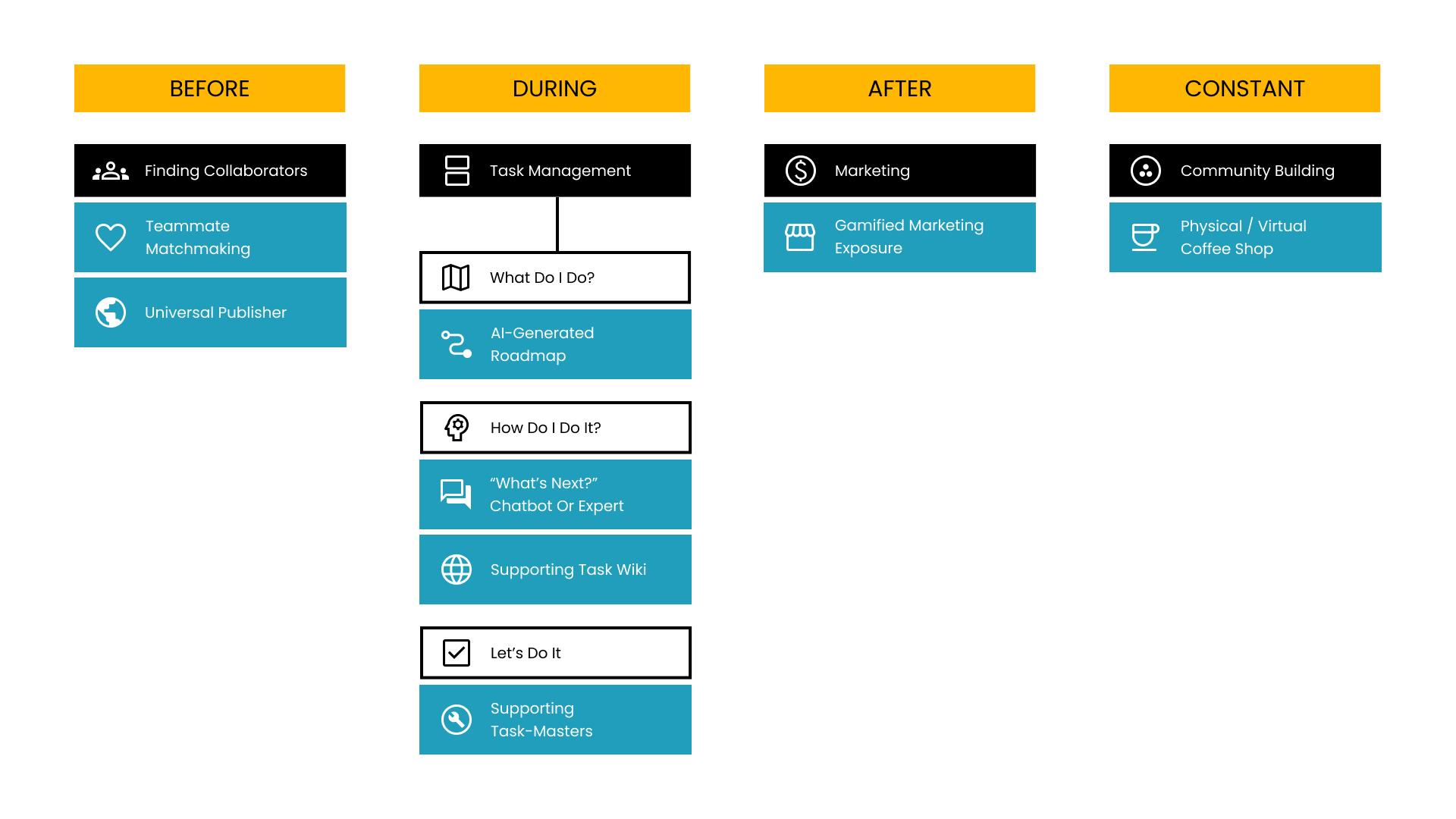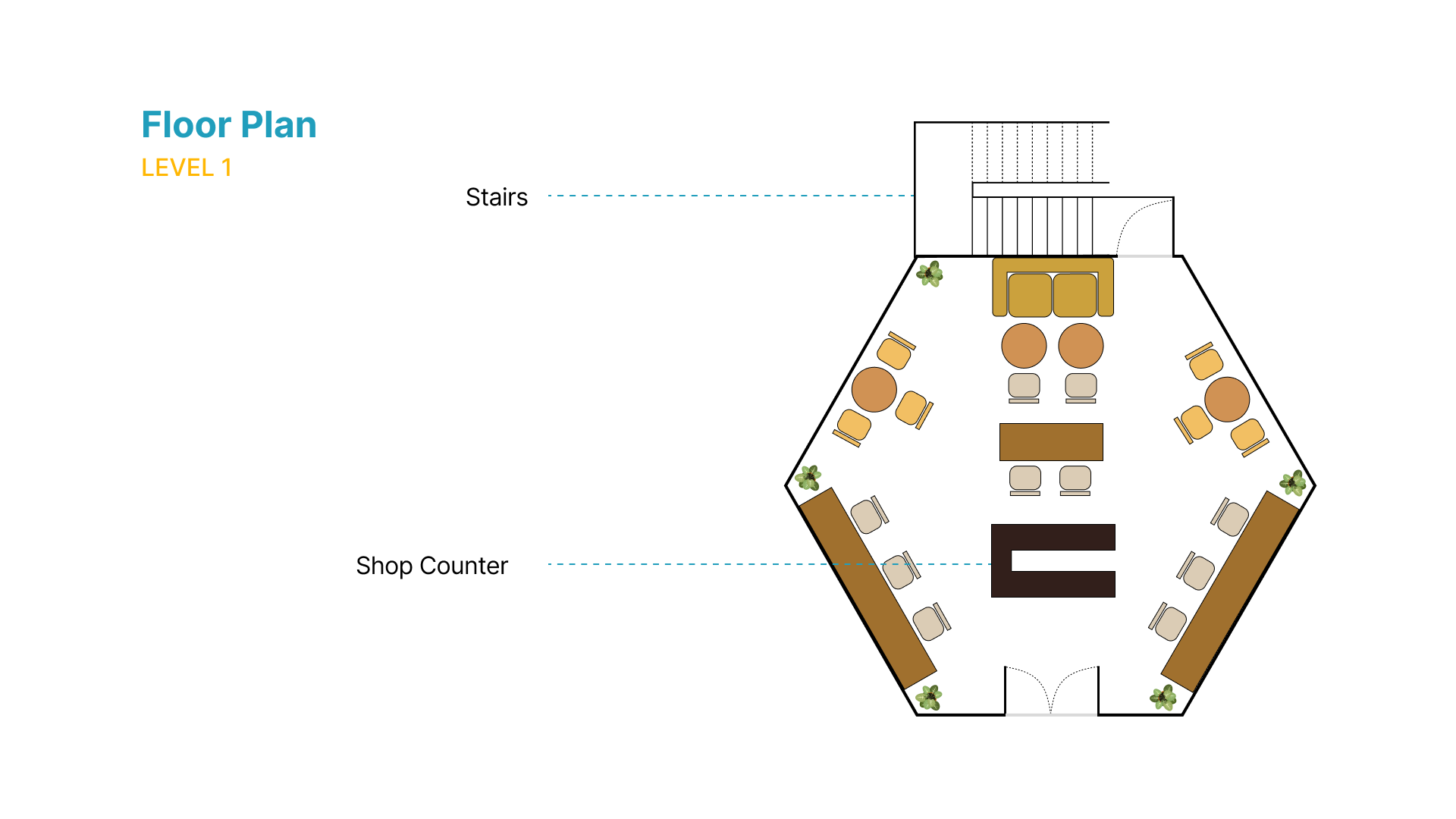Cluster
Cluster is a combined cafe and makerspace designed for independent creators (like game designers, filmmakers, and music producers) to connect and learn from one another.
-
6-month project
2-person group
Q1-Q3 2022
-
Product Designer
-
User Research
User Interviews
Insight Gathering
Sketching and Ideation
Storyboarding
Prototyping
Product Presentation
-
Mobile
Web
Service Design
The Problem
Independent creators— game designers, filmmakers and music producers— must make substantial life sacrifices to achieve success in their respective industries. How can they be helped?
As a designer with hopes to enter a creative field after school, who has tackled independent creative projects myself, the trials and triumphs of independent creators resonated deeply.
Secondary Research
We found that independent creators enjoyed critical success comparable to large studios with greater resources, while operating as solo actors or on small teams.
I researched creators from artistic domains that we were interested in, in order to discover their greatest obstacles. This included game designers, filmmakers, and music producers.
The Supporting Tasks
Creators prevailed despite major impediments that existed outside of their creative work, which we dubbed “supporting tasks.” These include but aren’t limited to:
Team Size 500
Development Cost $174m
Metacritic Score 86
Team Size 3
Development Cost $42k
Metacritic Score 87
Small teams are capable of creating experiences of similar caliber to AAA companies with far fewer resources.
How Might We
How might independent creators working solo or on small teams minimize their non-creative supporting tasks?
I realized that these supporting tasks can be crippling for independent creators, who already lack the time and resources to create due to everyday responsibilities, like a full-time job or family obligations. I could help independent creators maximize their available time working on creative tasks, and developed the following design question.
“We can all agree that the goal is to create awesome games. But in order to do so, you need to also spend time on building a company and a team, find funding and do PR and tons of other non-game-dev issues. Deciding on how to spend team resources between the actual game development and everything else is super hard.”
Primary Research
How do independent creators know which supporting tasks they must execute for their projects, what are they, and how do they manage them?
Sensemaking
Data from the interviews was parsed using a Miro affinity diagram, which sorted quotes from participants into organizational structures, separated by our research sub-questions.
Clustering responses that pertain to one of our research sub-questions.
Supporting Task Model
More than anything else, creators must communicate with the various stakeholders who complete, distribute, fund, and enjoy their project.
Before conjuring insights, it was necessary to map out which supporting tasks creators actually engage in, according to our data. A creator’s main supporting responsibility is project management, described as the efficient navigation of required tasks to enjoy success with one’s project. While this does include administrative tasks like resource tracking and publishing, the main element of project management is stakeholder communication.
Insight 01
Creators waste time acquiring skills to do supporting tasks due to the lack of a centralized learning source.
“There is significantly less content out there on how to start and manage a studio, how to make the relationships that you need to make in order to find a continued path to success.”
Insight 02
Creators must ensure that their supporting networks are filled with trustworthy people who share their core values.
“You have to make sure you’re looking for the right type of person. And then you have to make sure that you work well together, because you’re going to be spending months [together], sometimes even a year, maybe even years, depending on the size of your work.”
Ideation and Downselection
In every stage of the creative process, independent creators lacked the support they needed.
I sketched out 20 concepts to contribute to a total of 40 with the key insights in mind. Rather than downselect, we realized that our concepts were all micro-solutions to a larger systems issue.
A rare analog instance of ideation and concept selection.
The Systems Issue
This diagram depicts the major responsibilities that arise as an independent creator completes a project. The blue elements are all solutions that we proposed and melded into one (subsequently realizing we had a systems issue on our hands).
The Idea
I proceeded with a digital-physical café.
I decided to include a collection of our ideated solutions into a larger support ecosystem model. This solution would be membership-based and provide local connections as well as online support resources.
This diagram explains the high-level goals of both the physical and digital spaces that the coffee shop service would offer.
Storyboard
Between the idea’s original conception and the execution of the storyboard, much of the online or AI-infused offerings had been scrapped in order to prioritize making human connections with people in the physical space. I also incorporated a dedicated makerspace in addition to the coffee shop, to award for more messy collaborative interaction and equipment rentals, juxtaposed with a quieter café space. Breaking off the makerspace are classrooms for creators to hold workshops that will get posted for online review later in the day.
Initial Design Concept
Our story went through a round of critique, and was again refined. I updated the supporting tasks our main actor, Juliana, needed help with to create a more cohesive narrative, I changed the classrooms into domain-specific workspaces that could be rented out by creators for intensive work sessions, we built the first iteration of screens, and I spread out Juliana’s story over time, making it come full circle by having her finish her film, using what she’d learned to teach less experienced creators.
This diagram was used to determine which features we wanted to include in the story, and in what depth we'd like to cover them.
Branding and Design Iteration
I was informed through critique that our design artifacts made the space look “like a bank.”
Hmm, not quite right, is it? Thus, I rebranded the concept using the name “Cluster” as the crux of the visual design, developing hexagonal clusters as a major recurring motif. I updated the colors to lean more into the vibrancy of a creator space, as opposed to the professional and calmer colors in place back when the space was dubbed “Cafe Indiependence.” I designed multiple iterations between several rounds of critique before achieving cohesive and fluid experience design.
Logistical Analysis
In order to ensure that I grounded the space within real world constraints, I completed a service design blueprint and lean canvas for Cluster, which help to sort out some of the logistical problems that may arise when including such a substantial and critical physical element to the space.
Final Design
Build Community
Cluster is a space comprised of like-minded individuals willing to help one another get their projects over the line. Connect with people in your creative domain via the connector tool on our website, or simply say hello when you see folks in the space!
Gain New Skills
Cluster organizes member-run workshops to help creators with all types of tasks, from distribution of your work to establishing an LLC. And if you miss a workshop, don’t sweat it! All events are recorded and stored in a digital repository, with timestamped content for easy review.
Get Stuff Done
Cluster offers quality equipment and workspace rentals to help you access the tools you need for your project. And once it’s done, help us help you celebrate it by hosting a screening, playtest, or listening party!
Design Specifications
Impact
I performed a capstone defence for Cluster, which involved multiple rounds of presentation and critique.
Professors and industry professionals inquired about the feasibility of the product, and I discussed potential limitations of the design scope. The project was universally commended across these critical settings.
Audrey and I at our poster session.












































































